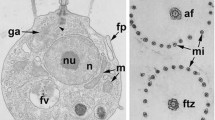Summary
Flagellated vegetative cells of the colonial golden algaSynura uvella Ehr, were examined using serial sections. The two flagella are nearly parallel as they emerge from a flagellar pit near the apex of the cell. The photoreceptor is restricted to swellings on the flagella in the region where they pass through the apical pore in the scale case and the swellings are not associated with the cell membrane or an eyespot. A unique ring-like structure surrounds the axonemes of both flagella at a level just above the transitional helix. The basal bodies are interconnected by three striated, fibrous bands. Four short (<100 nm) microtubules lie between the basal bodies at their proximal ends. Two rhizoplasts extend down from the basal bodies and separate into numerous fine striated bands which lie over the nucleus. Three- and four-membered microtubular roots arise from the rhizoplasts and extend apically together. As the roots reach the cell anterior, the three-membered root bends and curves clockwise to form a large loop around the flagella; the four-membered root bends anticlockwise and terminates under the distal end of the three-membered root as it completes the loop. There are four absolute orientations, termed Types 1–4, in which the flagellar apparatus can occur. With each orientation type the positions of the Golgi body, nucleus, rhizoplasts, chloroplasts and microtubular roots change with respect to the flagella, basal bodies and photoreceptor. Two new basal bodies appear in pre-division cells, and three short microtubules appear in a dense substance adjacent to each new basal body. Based upon the positions of new pre-division basal bodies, a hypothesis is proposed to explain why there are four orientations and how they are maintained through successive cell divisions.
Similar content being viewed by others
References
Andersen, R. A., Mulkey, T. J., 1983: The occurrence of chlorophylls c1 and c2 in thechrysophyceae. J. Phycol.19, 289–294.
Belcher, J. H., 1969: Some remarks uponMallomonas papillosa Harris and Bradley andM. calceolus Bradley. Nova Hedw.18, 257–270.
Bouck, G. B., Brown, D. L., 1972: Microtubule biogenesis and cell shape inOchromonas. I. The distribution of cytoplasmic and mitotic microtubules. J. Cell Biol.56, 340–359.
Bourrelly, P., 1957: Recherches sur les Chrysophycées. Revue algol., Mém. Hors. Sér.1, 1–412.
Chapman, R. L., 1980: Ultrastructure ofCephaleuros virescens (Chroolepidaceae; Chlorophyta). II. Gametes. Amer. J. Bot.76, 10–17.
Cole, G. T., Wynne, M. J., 1974: Endocystosis ofMicrocystis aeruginosa byOchromonas danica. J. Phycol.10, 397–410.
Floyd, G. L., Hoops, H. J., Swanson, J. A., 1980: Fine structure of the zoospore ofUlothrix belkae with emphasis on the flagellar apparatus. Protoplasma104, 17–31.
—,O'Kelly, C. J., 1984: Motile cell ultrastructure and the circumscription of the ordersUlotrichales andUlvales (Ulvophyceae, Chlorophyta). Amer. J. Bot.71, 111–120.
Foster, K. W., Smyth, R. D., 1980: Light antennas in phototactic algae. Microbiol. Rev.44, 572–630.
Gibbs, S. P., 1962: Nuclear envelope-chloroplast relationships in algae. J. Cell Biol.14, 433–444.
—, 1970: The comparative ultrastructure of the algal chloroplast. Ann. N.Y. Acad. Sci.175, 454–473.
Hibberd, D. J., 1976: The ultrastructure and taxonomy of theChrysophyceae andPrymnesiophyceae (Haptophyceae): a survey with some new observations on the ultrastructure of theChrysophyceae. Bot. J. Linn. Soc.72, 55–80.
—, 1978: The fine structure ofSynura sphagnicola (Korsh.) Korsh. (Chrysophyceae). Br. phycol. J.13, 403–412.
Melkonian, M., 1978: Structure and significance of cruciate flagellar root systems in green algae: Comparative investigations in species ofChlorosarcinopsis (Chlorosarcinales). Pl. Syst. Evol.130, 265–292.
—, 1981: The flagellar apparatus of the scaly green flagellatePyramimonas obovata: Absolute configuration. Protoplasma108, 341–355.
—,Berns, B., 1983: Zoospore ultrastructure in the green algaFriedmannia israelensis: An absolute configuration analysis. Protoplasma114, 67–84.
Mignot, J. P., 1974: Étude ultrastructurale d'un protiste flagellé incolore:Pseudodendromonas vlkii Bourrelly. Protistologica10, 397–412.
—,Brugerolle, G., 1982: Scale formation inChrysomonad flagellates. J. Ultrastruct. Res.81, 13–26.
Moestrup, O., 1978: On the phylogenetic validity of the flagellar apparatus in green algae and other chlorophylla andb containing plants. BioSystems10, 117–144.
—, 1982: Flagellar structure in algae: a review, with new observations particularily on theChrysophyceae, Phaeophyceae (Fucophyceae),Euglenophyceae, andReckertia. Phycologia21, 427–528.
O'Kelly, C. J., Floyd, G. L., 1984: Flagellar apparatus absolute orientations and the phylogeny of the green algae. BioSystems16, 227–251.
- -1985: Absolute configuration analysis of the flagellar apparatus inGiraudyopsis sp. (Chrysophyceae, Sarcinochrysidales) zoo-spores, and its significance in considerations of the systematics and evolution of thePhaeophyceae. Phycologia24 (in press).
Pascher, A., 1914: Über Rhizopoden- und Palmellastadien bei Flagellaten (Chrysomonaden), nebst einer Übersicht über die braunen Flagellaten. Arch. Protistenk.25, 153–200.
Robinson, D. G., Quader, H., 1980: Topographical features of the membrane ofPoterioochromonas malhamensis after colchicine and osmotic treatment. Planta148, 84–88.
Schnepf, E., Deichgräber, G., 1969: Über die Feinstruktur vonSynura petersenii unter besonderer Berücksichtigung der Morphogenese ihrer Kieselschuppen. Protoplasma68, 85–106.
Schnepf, E., Deichgräber, G., Roderer, G., Herth, W., 1977: The flagellar root apparatus, the microtubular system and associated organelles in the Chrysophycean flagellate,Poterioochromonas malhamensis Peterfi (syn.Poterioochromonas stipitata Scherffel andOchromonas malhamensis Pringsheim). Protoplasma92, 87–107.
Slantkis, T., Gibbs, S. P., 1972: The fine structure of mitosis and cell division in the Chrysophycean algaOchromonas danica. J. Phycol.8, 243–256.
Stewart, K. D., Mattox, K. R., 1978: Structural evolution in the flagellated cells of green algae and land plants. BioSystems10, 145–152.
— —, 1980: Phylogeny of the phytoflagellates. In: Phytoflagellates (Cox, E. R., ed.), pp. 433–462. New York: Elsevier/North-Holland.
Wujek, D. E., 1978: Ultrastructure of flagellated chrysophytes. III.Mallomonas caudata. Trans. Kansas Acad. Sci.81, 327–335.
Author information
Authors and Affiliations
Rights and permissions
About this article
Cite this article
Andersen, R.A. The flagellar apparatus of the golden algaSynura uvella: Four absolute orientations. Protoplasma 128, 94–106 (1985). https://doi.org/10.1007/BF01276332
Received:
Accepted:
Issue Date:
DOI: https://doi.org/10.1007/BF01276332



